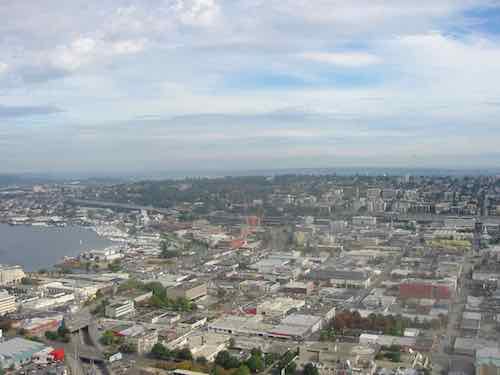Readers: OK To Raze For Amazon’s HQ2
Last week Amazon announced it planned to build a second headquarters somewhere in North America. Every Metropolitan Statistical Area (MSA) of at least 1 million people is likely interested in attracting Amazon. That’s roughly 50 regions just in the US, the St. Louis region is 20th in size on this list. Though we’ve been Amazon Prime members for at least 5 years, I wasn’t very familiar with their Seattle headquarters. I still thought they were on Beacon Hill, but they’d moved to a part of Seattle I’ve visited numerous times over the last 25 years: South Lake Union.
Several years ago we outgrew our space and we made a conscious choice to invest in downtown Seattle—even though it would have been cheaper to move to the suburbs. We now employ more than 40,000 people in Seattle who come from all around the world. Our employees tell us that they love being in the heart of the city. In fact, about 15% live in the same zip code as their office and about 20% walk to work. And they frequent the restaurants, food trucks and shops that have popped up all around South Lake Union, the neighborhood in Seattle we call home. (Amazon)
This video shows how they feel about their “urban campus.”
My last visit to Seattle was in the Spring of 2009, before Amazon moved to South Lake Union, I rode their new modern Seattle Streetcar. Streetfilms posted a video about the same time I was there.
Construction on condos & offices was happening, but there was still lots of low-rise buildings and surface parking lots.

In 2003 their streetcar project was just a dream.
You don’t have to be a lifelong Seattleite to remember the old, down-at-heel South Lake Union of the 1990s — less a neighborhood than a patchwork of parking lots, warehouses and low-slung industrial buildings. It felt like a ghost town, even at midday.
No more.
Today, 36,000 people work in the neighborhood, almost a 50 percent jump just since 2009, the year before Amazon relocated its headquarters here from Beacon Hill. At the corner of Westlake and Denny — where Whole Foods opened in 2006 — the number of pedestrians nearly quadrupled in just five years, according to counts conducted by the Downtown Seattle Association. At peak time, 1,711 people cross there every hour — their faces buried in their phones, no doubt.On a stroll down Westlake Avenue, you can shop for swank home goods at West Elm, dine at Tom Douglas’ upscale pizza parlor or even splurge on an electro-luxury car at the Tesla showroom. (Seattle Times w/before & after photos)
What does this have to do with St. Louis’ bid to land Amazon’s HQ2? Everything.
First, I think the modern streetcar investment was a big incentive for Amazon when they selected South Lake Union over suburban sites. Had St. Louis moved forward on the St. Louis Streetcar project connecting downtown to the Central West End we’d be in a much better position. Modern streetcar lines and light rail lines use the same vehicles — the placement/design of the tracks is the difference, Light rail is great for moving people smoothly over long distances at speeds equal to or faster than bus/car. Light rail, however, can’t compete with the modern streetcar line for revitalizing a corridor through increased economic development, pedestrian activity, etc. The bus isn’t a smooth ride! Vox took a critical look at streetcars, watch their video here.
Second, our campuses are anti-urban monstrosities. Take Saint Louis University or the BJC/Washington University Medical campuses as examples — both have decimated the street grid. Both have created a gated enclave atmosphere. Chicago’s Northwestern Medical campus, like Amazon’s HQ1, has retained the street grid and is not contiguous. Amazon wants regions to be creative, HQ2 may or may not resemble;e HQ1.
More than half of those who voted in the recent non-scientific Sunday Poll favor razing an existing area to get HQ2:
Q: Agree or disagree: Leveling an existing area would be worth it to get Amazon’s HQ2.
- Strongly agree 13 [28.26%]
- Agree 5 [10.87%]
- Somewhat agree 9 [19.57%]
- Neither agree or disagree 2 [4.35%]
- Somewhat disagree 5 [10.87%]
- Disagree 5 [10.87%]
- Strongly disagree 5 [10.87%]
- Unsure/No Answer 2 [4.35%]
I’m more cautious. A friend lived in Seattle for many years until Amazon relocated to South Lake Union (SLU). His Capital Hill neighborhood, up from SLU, changed dramatically in a short period. It became even more expensive. He sold his place to a young college grad just starting at Amazon.
I am curious to see what St. Louis, and all the other cities, will submit to Amazon for consideration.
Further reading:
- Amazon’s HQ2 page
- Amazon’s Request For Proposals
- St. Louis Post-Dispatch: Amazon probably won’t pick St. Louis, but we can learn from losing
- CNN/Money: 8 cities fit for Amazon’s second headquarters
- Fast Company: Amazon’s Quest For An HQ2 Underscores Seattle Growing Pains
- Fortune commentary: How Cities Can Win the Fight for Amazon’s HQ2
- Wired: DOES AMAZON REALLY NEED A $5 BILLION SECOND HQ? MAYBE.
- Washington Post: What Amazon’s HQ2 plan gets right: Move the jobs to the workers
Cities have until just October 19th to submit proposals, a winner is to be selected next year. Hopefully we’ll see a list a finalists between now and then, they’ll probably be asked to submit additional information and host Amazon executives.
The process, the first of its kind, is fascinating to watch.
— Steve Patterson